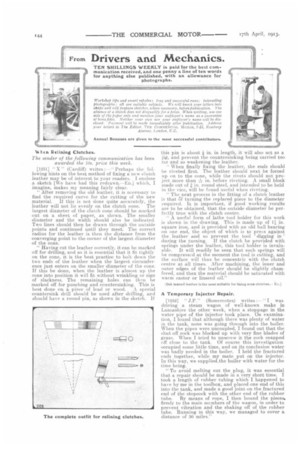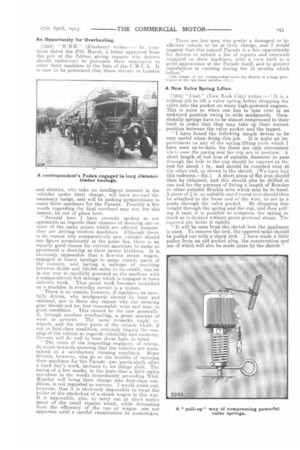lien Relining Clutches.
Page 20

Page 21

If you've noticed an error in this article please click here to report it so we can fix it.
The sender of the following communication has been awarded the 10s. prize this week.
[12511 "X " (Cardiff) writes :—" Perhaps the following hints on the best method of fixing a new clutch leather may be of interest to your readers, I enclose a, sketch [We have had this redrawn—En.] which, I imagine, makes my meaning fairly clear.
" After removing the old leather, it is necessary to find the required curve for the cutting of the new material. If this is not done quite accurately, the leather will not lie evenly on the clutch cone. The largest diameter of the clutch cone should be marked out on a sheet of paper, as shown. The smaller diameter and the width should also be indicated. Two lines should then be drawn through the outside points and continued until they meet, The correct radius for the leather is then the distance from the converging point to the corner of the largest diameter of the cone.
" Having cut the leather correctly, it can be marked off for drilling, and as it is essential that it fit tightly on the cone, it is the best practice to bolt down the two ends of the leather when the largest circumference just enters on the smaller diameter of the cone. If this be done, when the leather is almost up the cone into position it will fit without wrinkling or sign of slackness. The remaining holes can then be marked off for punching and countersinking. This is hest done on a piece of lead or wood. A special countersink drill should he used after drilling, and should have a round pin, as shown in the sketch. If this pin is about * in. in length, it will also act as a jig, and prevent the countersinking being carried too far and so weakening the leather.
" When finally fixing the leather, the ends should be riveted first. The leather should next be forced up on to the cone, while the rivets should not project more than -OF in, before riveting. A small block made out of in. round steel, and intended to be held in the vice, will be found useful when riveting.
"The next process in the fitting of a clutch leather is that if turning the replaced piece to the diameter required. It is important, if good working results are to be obtained, that the outside diameter be perfectly true with the clutch centre.
A useful form of Lathe tool holder for this work is shown in the drawing. This is made up of 11 in. square iron, and is provided with an old ball bearing on one end, the object of which is to prm:s against the leather and so prevent the tool digging in ' during the turning. If the clutch be provided with springs under the leather, this tool holder is invaluable. It will readily be seen that such springs will be compressed at the moment the tool is cutting, and the surface will thus be concentric with the clutch centre at all times. After machining, the inner and outer edges of the leather should be slightly chamfered, and then the material should be saturated with warm castor or linseed oil."
[Oak tanned leather is the most suitable for lining none clutches.
A Temporary Injector Repair.
02523 "J.P." (Somercotes) writes I was
driving a steam wagon of well-known make in Lancashire the other week, when a stoppage in the water pipe of the injector took place. On examination, I found that although there was plenty of wa.ter in the tank, none was going through into the boiler. When the pipes were uncoupled, I found out that the shut-off cock was blocked up with very fine blades of grass. When I tried to unscrew it the cock snapped off close to the tank. Of course this investigation occupied some little time, and on its conclusion water was badly needed in the boiler. I held the fractured ends together, while my mate put on the injector. In this way, we supplied.the boiler with water for the time being. "To avoid melting out the plug, it was essential that a eepair should be made in a very short time. I Wok a length of rubber tubing which I happened to have by me in the toolbox, and placedone end of this into the tank, and made a good joint on the fractured end of the stopcock with the other end of the rubber tube. By means of rope, I then bound the pieces. firmly to the main members of the wagon, in order to prevent vibration and the shaking off of the rubber tube. Running in this way, we managed to cover a distance of ae miles."
An Opportunity for Overhauling.
[1253] " W.B.H." (Finsbury) write .s :—•• In your issue dated the 27th March, a letter appeared from the pen of the Editor, giving reasons why drivers should endeavour to persuade their employers to enter their machines in the lists of the C.M.U.A. It, is now to be presumed that those drivers in London and district, who take an intelligent interest in the vehicles under their charge, will have secered the necessary badge, and will be making preparations to enter their machines for the Parade. Possibly a few words regarding the final overhaul may not, for this reason, be out of place here.
" Several men I have recently spoken to are optimistic as regards their chances of securing one-or more of the many prizes which are offered, because they are driving modern machines. Although there is no reason why comparatively new vehicles should not figure prominently in the prize list, there is an equally good chance for veteran machines to make as prominent a showing as their newer brethren. It is obviously impossible that a five-ton steam wagon, engaged in heavy haulage to many remote parts of the country, and having a mileage of anything between 20,000 and 100,000 miles to its credit, can be in any way so carefully guarded as the machine with a, comparatively-low mileage which is engaged in town delivery work. That paint work becomes tarnished on a machine in everyday service is a truism. " There is no reason, however, if machines be carefully driven, why mudguards should be bent and strained, nor is there any reason why the steering gear should not be, less reasonable wear and tear, in good condition. This cannot be the case generally if, through careless overhauling, a great amount of wear is present. The same remarks apply to wheels, and the other parts of the vehicle which, if not in first-class condition, seriously impair the running of the vehicle as regards reliability and economy. Drivers will do well to bear these facts in mind.
" The visits of the inspecting engineer, of course, do much towards ensuring that the vehicles are maintained in a satisfactory running condition. Some drivers, however, who go to the trouble of entering their machines for the Parade, are, particularly after a bard day's work, inclined to let things slide. The losing of a few marks, in the hope that a little extra attention in the weeks immediately preceding Whit Monday will bring their charge into first-class condition, is not regarded as serious. I would point out, however, that it is obviously impossible to treat the boiler or the smokebox of a steam wagon in this way. It is impossible, also, to carry out at short notice many of the small repairs which, while detracting from the efficiency of the van or wagon, are not apparent until a careful examination be undertaken. There are few men who prefer a damaged or inefficient vehicle to be in their charge, and I would suggest that this annual Parade is a fine opportunity for drivers to submit a list of repairs and renewals required on their machines, with a view both to a good appearance at the Parade itself, and to greater satisfaction in running during the 12 months which follow."
rhe initials of our correspondent cover the identity of a large prizew;nner at the last three paradea.—ED.l.
A New Valve Spring Lifter.
[1254] " Cosh " (New York City) writes :—" It is a tedious job to lift a valve spring before dropping the valve into the pocket on many high-powered engines. This is more so when one has to lean over in an awkward position owing to wide mudguards. Occasionally springs have to be almost compressed to their limit in order that they may take up their correct position between the valve pocket and the tappet. " I have found the following simple device to be very useful when doing this job. It is quite an improvement on any of the swing-lifting tools which I have seen up-to-date, for these are only convenient when once the spring and the cup are in position. A short length of rod iron of suitable diameter to pass through the hole in the cup should be tapered at the end for about 1 in., and should be rounded over at the other end, as shown in the sketch. [We have had this redrawn.—E.]. A short piece of fiat iron should then be obtained, and this should also be drilled at one end for the purpose of fitting a length of Bowden or other suitable flexible wire which may be to hand. A piece of in. or suitably-sized round iron should then be attached to the loose end of the wire, to act as a guide through the valve pocket. By dropping this weight through the spring and the cup, and then pulling it taut, it is possible to compress the spring as much as is desired without great personal strain. The tapered pin holds it tightly. "It will be seen from the sketch how the appliance is used. To remove the tool, the tapered spike should be pulled out with a sharp jerk. I have made a little pulley from an old pocket plug, the construction and use of which will also be made plain by the sketch."






















